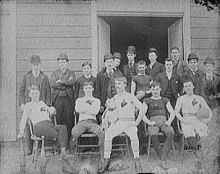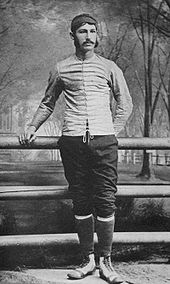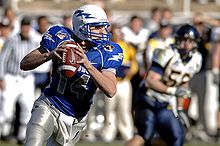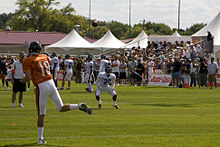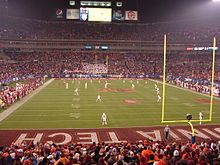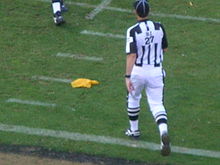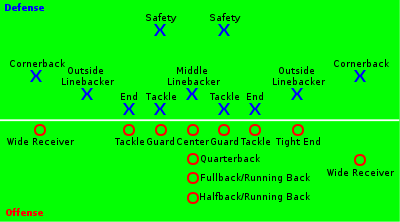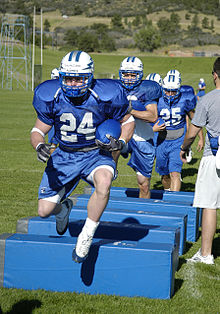- American football
-
For other uses, see American football (disambiguation).
American football 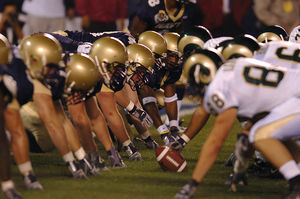
The U.S. Naval Academy Midshipmen (left) face off against the Colorado State Rams.Nickname(s) Gridiron First played November 6, 1869, Rutgers vs. Princeton Characteristics Contact Full contact Team members 11 at a time Categorization Outdoor Equipment Football Olympic No American football is a sport played between two teams of eleven with the objective of scoring points by advancing the ball into the opposing team's end zone. Known in the United States simply as football, it may also be referred to informally as gridiron football.[1][2] The ball can be advanced by running with it or throwing it to a teammate. Points can be scored by carrying the ball over the opponent's goal line, catching a pass thrown over that goal line, kicking the ball through the opponent's goal posts or tackling an opposing ball carrier in his own end zone.
In the United States, the major forms are high school football, college football and professional football. Each of these are played under slightly different rules.[3] High school football is governed by the National Federation of State High School Associations and college football by the National Collegiate Athletic Association and National Association of Intercollegiate Athletics. The major league for professional football is the National Football League.
American football is closely related to Canadian football but with some differences in rules and the field.[4] Both sports can be traced to early versions of association football and rugby football.
Contents
History
Main article: History of American footballThe history of American football can be traced to early versions of rugby football and association football. Both games have their origins in varieties of football played in the United Kingdom in the mid-19th century, in which a ball is kicked at a goal and/or run over a line. Many games known as "football" were being played at colleges and universities in the United States in the first half of the 19th century.[5][6] Modern American football grew off a historical game played between Harvard and McGill University in 1874.[citation needed]
Rutgers University and its neighbor, Princeton University, played the first game of intercollegiate football on 6 November 1869 on a plot of ground where the present-day Rutgers gymnasium now stands in New Brunswick, N.J. Rutgers won that first game, 6-4.[7]
American football resulted from several major divergences from rugby football, most notably the rule changes instituted by Walter Camp, considered the "Father of American Football." Among these important changes were the introduction of the line of scrimmage and of down-and-distance rules. In the late 19th and early 20th centuries, game play developments by college coaches such as Eddie Cochems, Amos Alonzo Stagg, Knute Rockne, and Glenn "Pop" Warner helped take advantage of the newly introduced forward pass.
The popularity of collegiate football grew as it became the dominant version of the sport for the first half of the twentieth century. Bowl games, a college football tradition, attracted a national audience for collegiate teams. Bolstered by fierce rivalries, college football still holds widespread appeal in the US.[5][8][9]
The origin of professional football can be traced back to 1892, with William "Pudge" Heffelfinger's $500 contract to play in a game for the Allegheny Athletic Association against the Pittsburgh Athletic Club. The first Professional "league" was the Ohio League, formed in 1903, and the first Professional Football championship game was between the Buffalo Prospects and the Canton Bulldogs in 1919. In 1920, the American Professional Football Association was formed. The first game was played in Dayton, Ohio on October 3, 1920 with the host Triangles defeating the Columbus Panhandles 14–0. The league changed its name to the National Football League (NFL) two years later, and eventually became the major league of American football. Initially a sport of Midwestern industrial towns in the United States, professional football eventually became a national phenomenon. Football's increasing popularity is usually traced to the 1958 NFL Championship Game, a contest that has been dubbed the "Greatest Game Ever Played". A rival league to the NFL, the American Football League (AFL), began play in 1960; the pressure it put on the senior league led to a merger between the two leagues and the creation of the Super Bowl, which has become the most watched television event in the United States on an annual basis.[10]
High school football dates to the 1880s and also enjoys regional popularity.
Rules
Main article: American football rulesField and players
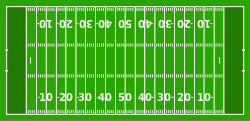 The numbers on the field indicate the number of yards to the nearest end zone.
The numbers on the field indicate the number of yards to the nearest end zone.
American football is played on a field 360 by 160 feet (120.0 by 53.3 yards; 109.7 by 48.8 meters).[11] The longer boundary lines are sidelines, while the shorter boundary lines are end lines. Sidelines and end lines are out of bounds. Near each end of the field is a goal line; they are 100 yards (91.4 m) apart. A scoring area called an end zone extends 10 yards (9.1 m) beyond each goal line to each end line. The end zone includes the goal line but not the end line.[11] While the playing field is effectively flat, it is common for a field to be built with a slight crown—with the middle of the field higher than the sides—to allow water to drain from the field.
Yard lines cross the field every 5 yards (4.6 m), and are numbered every 10 yards from each goal line to the 50-yard line, or midfield (similar to a typical rugby league field). Two rows of short lines, known as inbounds lines or hash marks, run at 1-yard (91.4 cm) intervals perpendicular to the sidelines near the middle of the field. All plays start with the ball on or between the hash marks. Because of the arrangement of the lines, the field is occasionally referred to as a gridiron in a reference to the cooking grill with a similar pattern of lines.
At the back of each end zone are two goalposts (also called uprights) connected by a crossbar 10 feet (3.05 m) from the ground. For high skill levels, the posts are 18 feet 6 inches (5.64 m) apart. For lower skill levels, these are widened to 23 feet 4 inches (7.11 m).
Each team has 11 players on the field at a time. Usually there are many more players off the field (an NFL team has a limit of 53 players on their roster, 46 of which can be dressed for a game). However, teams may substitute for any or all of their players during the breaks between plays. As a result, players have very specialized roles and are divided into three separate units: the offense, the defense and the special teams. It is rare for all team members to participate in a given game, as some roles have little utility beyond that of an injury substitute.
Start of halves
The game begins with a coin toss to determine which team will kick off to begin the game and which goal each team will defend.[12] The options are presented again to start the second half; the choices for the first half do not automatically determine the start of the second half. The referee conducts the coin toss with the captains (or sometimes coaches) of the opposing teams. The team that wins the coin toss has three options:[12]
- They may choose whether to kick or receive the opening kickoff.
- They may choose which goal to defend.
- They may choose to defer the first choice to the other team and have first choice to start the second half.[13]
Whatever the first team chooses, the second team has the option on the other choice (for example, if the first team elects to receive at the start of the game, the second team can decide which goal to defend).
At the start of the second half, the options to kick, receive, or choose a goal to defend are presented to the captains again. The team which did not choose first to start the first half (or which deferred its privilege to choose first) now gets first choice of options.[12][14]
Game duration
A standard football game consists of four 15-minute quarters (12-minute quarters in high-school football and often shorter at lower levels),[15] with a half-time intermission after the second quarter.[16] Depending upon the level of competition, the duration of the half-time ranges from 10 to 20 minutes. At all levels, a down (play) that begins before time expires is allowed to continue until its completion, even after the clock reaches zero. The clock is also stopped after certain plays, therefore, a game can last considerably longer (often more than three hours in real time), and if a game is broadcast on television, TV timeouts are taken at certain intervals of the game to broadcast commercials outside of game action. If an NFL game is tied after four quarters, the teams play an additional period lasting up to 15 minutes. In a regular season NFL overtime game, the first team that scores wins, even if the other team does not get a possession; this is referred to as sudden death. However, in a post-season NFL game during the playoffs, if the first team with possession scores only a field goal, the other team is allowed the opportunity to match or better this score. This rule only affects playoff games in overtime in which the first team with possession scores a field goal: if the first team with possession scores a touchdown, the sudden death rules take effect. In a regular-season NFL game, if neither team scores in overtime, the game is a tie. In an NFL playoff game, additional overtime periods are played, as needed, to determine a winner. College overtime rules are more complicated.
 A line of scrimmage on the 48-yard line. The offense is on the left.
A line of scrimmage on the 48-yard line. The offense is on the left.
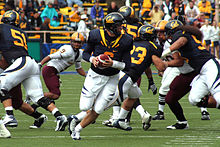 A quarterback searching for opportunity to throw a pass.
A quarterback searching for opportunity to throw a pass.
 A running back being tackled when he tries to run with the ball.
A running back being tackled when he tries to run with the ball.
Advancing the ball
The team that takes possession of the ball (the offense) has four attempts, called downs, in which to advance the ball at least 10 yards toward their opponent's (the defense's) end zone. When the offense succeeds in gaining at least 10 yards, it gets a first down, meaning the team starts a new set of four downs to gain yet another 10 yards or to score. If the offense fails to gain a first down (10 yards) after four downs, the other team gets possession of the ball at the point where the fourth down ended, beginning with their first down to advance the ball in the opposite direction.
Except at the beginning of halves and after scores, the ball is always put into play by a snap. Offensive players line up facing defensive players at the line of scrimmage (the position on the field where the play begins). One offensive player, the center, then passes (or "snaps") the ball backwards between his legs to a teammate behind him, usually the quarterback.
Players can then advance the ball in two ways:
- By running with the ball, also known as rushing.
- By throwing the ball to a teammate, known as a pass or as passing the football. If the pass is thrown down-field, it is known as a forward pass. The forward pass is a key factor distinguishing American and Canadian football from other football sports. The offense can throw the ball forward only once during a down and only from behind the line of scrimmage. However, the ball can be handed-off to another player or thrown, pitched, or tossed sideways or backwards (a lateral pass) at any time.
A down ends, and the ball becomes dead, after any of the following:
- The player with the ball is forced to the ground (a tackle) or has his forward progress halted by members of the other team (as determined by an official).
- A forward pass flies beyond the dimensions of the field (out of bounds) or touches the ground before it is caught. This is known as an incomplete pass. The ball is returned to the most recent line of scrimmage for the next down.
- The ball or the player with the ball goes out of bounds.
- A team scores.
Officials blow a whistle to notify players that the down is over.
Before each down, each team chooses a play, or coordinated movements and actions, that the players should follow on a down. Sometimes, downs themselves are referred to as "plays."
Change of possession
The offense maintains possession of the ball unless one of the following things occurs:
- The team fails to get a first down— i.e., in four downs they fail to move the ball past a line 10 yards ahead of where they got their last first down. The defensive team takes over the ball at the spot where the 4th-down play ends. A change of possession in this manner is commonly called a turnover on downs.
- The offense scores a touchdown or field goal. The team that scored then kicks the ball to the other team in a special play called a kickoff.
- The offense punts the ball to the defense. A punt is a kick in which a player drops the ball and kicks it before it hits the ground. Punts are nearly always made on fourth down, when the offensive team does not want to risk giving up the ball to the other team at its current spot on the field (through a failed attempt to make a first down) and feels it is too far from the other team's goal post to attempt a field goal.
- A defensive player catches a forward pass. This is called an interception, and the player who makes the interception can run with the ball until he is tackled, forced out of bounds, or scores.
- An offensive player drops the ball (a fumble) and a defensive player picks it up. As with interceptions, a player recovering a fumble can run with the ball until tackled, forced out of bounds, or scoring. Passes that are thrown either backwards or parallel with the line of scrimmage (lateral passes) that are not caught do not cause the down to end as incomplete forward passes do; instead the ball is still live as if it had been fumbled. Lost fumbles and interceptions are together known as turnovers.
- The offensive team misses a field goal attempt. The defensive team gets the ball at the spot where the previous play began (or, in the NFL, at the spot of the kick). If the unsuccessful kick was attempted from within 20 yards of the end zone, the other team gets the ball at its own 20 yard line (that is, 20 yards from the end zone). If a field goal is missed or blocked and the ball remains in the field of play, a defensive player may pick up the ball and attempt to advance it. In this last case, possession is awarded at the spot where the recovering player is ruled down.
- While in his own end zone, an offensive ball carrier is tackled, forced out of bounds, loses the ball out of bounds, or the offense commits certain fouls in the end zone. This fairly rare occurrence is called a safety.
- An offensive ball carrier fumbles the ball forward into the opposing end zone, and then the ball goes out of bounds. This rare occurrence leads to a touchback, with the ball going over to the opposing team at their 20 yard line (Note that touchbacks during non-offensive special teams plays, such as punts and kickoffs, are quite common).
Scoring
Main article: American_football_rules#ScoringA team scores points by the following plays:
- A touchdown (TD) is worth 6 points.[16] It is scored when a player runs the ball into or catches a pass in his opponent's end zone.[16] A touchdown is analogous to a try in rugby. Unlike rugby, a player does not have to touch the ball to the ground to score; a touchdown is scored any time a player has possession of the ball while any part of the ball is beyond the vertical plane created by the leading edge of the opponent's goal line stripe (the stripe itself is a part of the end zone).
- After a touchdown, the scoring team attempts a try (which is also analogous to the conversion in rugby). The ball is placed at the other team's 3 yard line (the 2 yard line in the NFL). The team can attempt to kick it through the goalposts (over the crossbar and between the uprights) in the manner of a field goal for 1 point (an extra point or point-after touchdown (PAT)[17]), or run or pass it into the end zone in the manner of a touchdown for 2 points (a two-point conversion). In college football, if the defense intercepts or recovers a fumble during a one or two point conversion attempt and returns it to the opposing end zone, the defensive team is awarded the two points.
- A field goal (FG) is worth 3 points, and it is scored by kicking the ball through the goalposts defended by the opposition.[16] Field goals may be place kicked (kicked when the ball is held vertically against the ground by a teammate) or drop kicked (extremely uncommon in the modern game due to the better accuracy of place kicks, with only two successful drop kicks in sixty-plus years in the NFL). A field goal is usually attempted on fourth down instead of a punt when the ball is close enough to the opponent's goalposts, or, when there is little or no time left to otherwise score.
- A safety, worth 2 points, is scored by the opposing team when the team in possession at the end of a down is responsible for the ball becoming dead behind its own goal line. For instance, a safety is scored by the defense if an offensive player is tackled, goes out of bounds, or fumbles the ball out of bounds in his own end zone.[16] Safeties are relatively rare. Note that, though even more rare, the team initially on offense during a down can score a safety if a player of the original defense gains possession of the ball in front of his own goal line and then carries the ball or fumbles it into his own end zone where it becomes dead. However, if the ball becomes dead behind the goal line of the team in possession and its opponent is responsible for the ball being there (for instance, if the defense intercepts a forward pass in its own end zone and the ball becomes dead before the ball is advanced out of the end zone) it is a touchback: no points are scored and the team last in possession keeps possession with a first down at its own 20 yard line. In the extremely rare instance that a safety is scored on a try, it is worth only 1 point.
Kickoffs and free kicks
Each half begins with a kickoff. Teams also kick off after scoring touchdowns and field goals. The ball is kicked using a kicking tee from the team's own 35 yard line in the NFL (as of the 2011 season) and 30 yard line in college football (as of the 2007 season). The other team's kick returner tries to catch the ball and advance it as far as possible. Where he is stopped is the point where the offense will begin its drive, or series of offensive plays. If the kick returner catches the ball in his own end zone, he can either run with the ball, or elect for a touchback by kneeling in the end zone, in which case the receiving team then starts its offensive drive from its own 20 yard line. A touchback also occurs when the kick goes out-of-bounds in the end zone. (Punts and turnovers in the end zone can also result in a touchback). A kickoff that goes out-of-bounds anywhere other than the end zone before being touched by the receiving team is a foul, and the ball will be placed within the hash marks of the yard line where it went out of bounds, or 30 yards from the kickoff spot, depending on which is more advantageous to the receiving team.[18] Unlike with punts, once a kickoff goes 10 yards and the ball has hit the ground, it can be recovered by the kicking team.[18] A team, especially one who is losing, can try to take advantage of this by attempting an onside kick.
After safeties, the team that gave up the points must free kick the ball to the other team from its own 20 yard line.[19]
Penalties
A penalty flag on the field during a game on November 16, 2008 between the San Francisco 49ers and St. Louis Rams. Main article: Penalty (American football)
Main article: Penalty (American football)Fouls (a type of rule violation) are punished with penalties against the offending team. Most penalties result in moving the football towards the offending team's end zone. If the penalty would move the ball more than half the distance towards the offender's end zone, the penalty becomes half the distance to the goal instead of its normal value.
Most penalties result in replaying the down. Some defensive penalties give the offense an automatic first down.[20] Conversely, some offensive penalties result in loss of a down (loss of the right to repeat the down).[20] If a penalty gives the offensive team enough yardage to gain a first down, they get a first down, as usual. The only penalty that results in points is if a team on offense commits a certain fouls, such as holding, in its own end zone, which results in a safety.
If a foul occurs during a down (after the play has begun), the down is allowed to continue and an official throws a yellow penalty flag near the spot of the foul. When the down ends, the team that did not commit the foul has the option of accepting the penalty, or declining the penalty and accepting the result of the down.
Variations
See also: List of gridiron football codes- Limited contact
- touch football. A play ends when a defender touches the ball carrier (sometimes with two hands).
- flag football. A play ends when a defender removes a designated token ("flag") worn by the ball carrier.
- Wrap. A play ends when a defender wraps his arms round the ball carrier.
- Fewer players
- Smaller field
- The Arena Football League is a league that plays eight-man football, but also plays indoors and on a much smaller playing surface with rule changes to encourage a much more offensive game.
- Catch and Run
- In this game, the children split into two teams and line up at opposite sides of the playing field. One side throws the ball to the other side. If the opposing team catches the ball, that player tries to run to the throwing teams touchdown without being tagged/tackled. If no one catches the ball or if the player is tagged/tackled, then that team has to throw the ball to the opposing team. This repeats until time runs out or the players decide to quit.
Players
Main article: American football positionsSee also: Formation (American football)Most football players have highly specialized roles. At the college and NFL levels, most play only offense or only defense.
Offense
- The offensive line (OL) consists of five players whose job is to protect the passer and clear the way for runners by blocking members of the defense. The lineman in the middle is the center. Outside the center are the guards, and outside them are the tackles. Except for the center, who snaps the ball to one of the backs, offensive linemen generally do not handle the ball.
- The quarterback (QB) receives the snap from the center on most plays. He then hands or tosses it to a running back, throws it to a receiver or runs with it himself. The quarterback is the leader of the offense and calls the plays that are signaled to him from the sidelines.
- Running backs (RB) line up behind or beside the QB and specialize in running with the ball. They also block, catch passes and, on rare occasions, pass the ball to others or even receive the snap. If a team has two running backs in the game, usually one will be a halfback (HB) (or tailback (TB)), who is more likely to run with the ball, and the other will usually be a fullback (FB), who is more likely to block.
- Wide receivers (WR) line up near the sidelines. They specialize in catching passes, though they also block for running plays or downfield after another receiver makes a catch.
- Tight ends (TE) line up next to the offensive line. They can either play like wide receivers (catch passes) or like offensive linemen (protect the QB or create spaces for runners). Sometimes an offensive lineman takes the tight end position and is referred to as a tackle eligible.[21]
At least seven players must line up on the line of scrimmage on every offensive play. The other players may line up anywhere behind the line. The exact number of running backs, wide receivers and tight ends may differ on any given play. For example, if the team needs only one yard, it may use three tight ends, two running backs and no wide receivers. On the other hand, if it needs 20 yards, it may replace all of its running backs and tight ends with wide receivers.
Defense
In contrast to members of the offense, the rules of professional football (NFL Rulebook) and American college football (NCAA Rulebook) do not specify starting position, movement, or coverage zones for members of the defensive team, except that they must be in the defensive zone at the start of play. The positions, movements and responsibilities of all defensive players are assigned by the team by selection of certain coverages, or patterns of placement and assignment of responsibilities. The positional roles are customary. These roles have varied over the history of American football. The following are customary defensive positions used in many coverages in modern American football.
- The defensive line consists of three to six players who line up immediately across from the offensive line. They try to occupy the offensive linemen in order to free up the linebackers, disrupt the backfield (behind the offensive line) of the offense, and tackle the running back if he has the ball before he can gain yardage or the quarterback before he can throw or pass the ball. They are the first line of defense.
- Behind the defensive line are the linebackers. They line up between the defensive line and defensive backs and may either rush the quarterback or cover potential receivers.
- The last line of defense is known as the secondary, comprising at least three players who line up as defensive backs, who are either cornerbacks or safeties. They cover the receivers and try to stop pass completions. They occasionally rush the quarterback.
Special teams
The units of players who handle kicking plays are known as special teams. Three important special-teams players are the punter, who handles punts, the placekicker or kicker, who kicks off and attempts field goals and extra points, and the long snapper, who snaps the ball for extra points, field goals, and punts. Also included on special teams are the returners. These players return punts or kickoffs and try to get in good field position. These players can also score touchdowns.
Uniform numbering
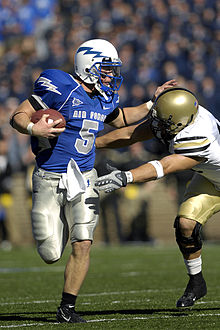 Quarterback Shaun Carney has uniform number 5.
Quarterback Shaun Carney has uniform number 5.
In the NFL, ranges of uniform numbers are (usually) reserved for certain positions:
- 1–19: Quarterbacks, punters and placekickers[22]
- 20–49: Running backs and defensive backs[23]
- 60–79: Offensive guards and tackles[24]
- 10–19, 80–89: Wide receivers[25]
- 80–89: Tight ends[26]
- Players who switch positions in their career can keep their number if they played their prior position for at least a year and move from a position that is eligible to receive passes to another eligible position, or if he is moving from one ineligible position to another ineligible position.[27][28]
NCAA and high school rules specify only that offensive linemen must have numbers in the 50–79 range, but the NCAA "strongly recommends" that quarterbacks and running backs have numbers below 50 and wide receivers numbers above 79.[29] This helps officials, as it means that numbers 50 to 79 are ineligible receivers, or players that may not receive a forward pass (except in the rare instance when a Tackle lines up as the outermost lineman on his side of the line and the officials are notified that he will be an eligible receiver for that particular play). There are no numbering restrictions on defensive players in the NCAA, other than that a team may not have two players on the field at the same time with the same jersey number.[30]
Basic strategy
Main article: American football strategyBecause the game stops after every down, giving teams a chance to call a new play, strategy plays a major role in football. Each team has a playbook of dozens to hundreds of plays. Ideally, each play is a scripted, strategically sound team-coordinated endeavor. Some plays are very safe; they are likely to get only a few yards. Other plays have the potential for long gains but at a greater risk of a loss of yardage or a turnover.
Generally speaking, rushing plays are less risky than passing plays. However, there are relatively safe passing plays and risky running plays. To deceive the other team, some passing plays are designed to resemble running plays and vice versa. These are referred to as play-action passes and draws, respectively. There are many trick or gadget plays, such as when a team lines up as if it intends to punt and then tries to run or pass for a first down. Such high-risk plays are a great thrill to the fans when they work. However, they can spell disaster if the opposing team realizes the deception and acts accordingly.
The defense also plans plays in response to expectations of what the offense will do. For example, a "blitz" (using linebackers or defensive backs to charge the quarterback) is often attempted when the team on defense expects a pass. A blitz makes downfield passing more difficult but exposes the defense to big gains if the offensive line stems the rush.
Many hours of preparation and strategizing, including film review by both players and coaches, go into the days between football games. This, along with the demanding physicality of football (see below), is why teams typically play at most one game per week.
Physicality
Main articles: Health issues in American football and American football protective equipmentAmerican football is a collision sport. To stop the offense from advancing the ball, the defense must tackle the player with the ball by knocking or pulling him down. As such, defensive players must use some form of physical contact to bring the ball-carrier to the ground, within certain rules and guidelines. Tacklers cannot kick or punch the runner. They also cannot grab the face mask of the runner's helmet or lead into a tackle with their own helmet ("spearing"). Despite these and other rules regarding unnecessary roughness, most other forms of tackling are legal. Blockers and defenders trying to evade them also have wide leeway in trying to force their opponents out of the way. Quarterbacks are regularly hit by defenders coming on full speed from outside the quarterback's field of vision. This is commonly known as a blindside.
To compensate for this, players must wear special protective equipment, such as a padded plastic helmet, shoulder pads, hip pads and knee pads. These protective pads were introduced decades ago and have improved ever since to help minimize lasting injury to players. An unintended consequence of all the safety equipment has resulted in increasing levels of violence in the game. Players may now hurl themselves at one another at high speeds without a significant chance of injury. The injuries that do result tend to be severe and often season or career-ending and sometimes fatal. In previous years with less padding, tackling more closely resembled tackles in Rugby football. Better helmets have allowed players to use their helmets as weapons. This form of tackling is particularly unwise, because of the great potential for brain or spinal injury. All this has caused the various leagues, especially the NFL, to implement a complicated series of penalties for various types of contact. Most recently, virtually any contact with the helmet of a defensive player on the quarterback, or any contact to the quarterback's head, is now a foul. During the late 1970s, the penalty in high school football for spearing included ejection from the game.[31]
Despite protective equipment and rule changes to emphasize safety, injuries remain very common in football. It is increasingly rare, for example, for NFL quarterbacks or running backs (who take the most direct hits) to make it through an entire season without missing some time to injury.[citation needed] Additionally, 28 football players died from direct football injuries in the years 2000–05 and an additional 68 died indirectly from dehydration or other examples of "non-physical" dangers, according to the National Center for Catastrophic Sport Injury Research.[32] Concussions are common, with about 41,000 suffered every year among high school players according to the Brain Injury Association of Arizona.[33] In 1981, U.S. President Ronald Reagan, who played football in high school, commented on the contact of the sport: "Football is the last thing left in civilization where men can literally fling themselves bodily at one another in combat and not be at war."[34]
Extra and optional equipment such as neck rolls, spider pads, rib protectors (referred to as "flak jackets"), and elbow pads help against injury as well, though they do not tend to be used by the majority of players due to their lack of requirement.
The danger of football, and the equipment required to reduce it, make regulation football impractical for casual play. Flag football and touch football are less violent variants of the game popular among recreational players.
Nutrition and dehydration
Football players typically begin their season while the weather is still extremely warm and with the dangerous combination of warm weather and high humidity, dehydration is a great risk for the players.[35] The players are usually required to follow a hydration schedule. It is extremely important for players to drink enough fluids because dehydration can seriously reduce athletic performance and increase the risk of heat illnesses. Most trainers and coaches make it imperative for their players to drink fluids before they are thirsty.[35]
Brain injury
The Concussions Committee of the NFL, co-chaired by Dr. Ira Casson, has generally denied that concussions result in permanent brain injury. However, there is some research, reported in 2009, which, using phone interviews based on the National Health Interview Survey, showed increased incidence of diagnosis of memory loss and dementia among retired professional football players; chronic traumatic encephalopathy diagnoses are increasingly common among deceased football players. Such symptoms are believed related to the effects of concussions. More rigorous research is being conducted by Dr. Casson, neurologist, for the NFL. This finding is considered significant as such injuries may potentially affect high school and college players also.[36]
Organization in the United States
Main article: American football in the United StatesIn the United States, the major forms are high school football, college football and professional football. Most American high schools field football teams. In general, high school teams play only against other teams within the same state, but there are some exceptions like nearby schools located on opposite sides of a state line.
Most of college football in the United States is governed by the National Collegiate Athletic Association (NCAA), and most colleges and universities around the country have football teams. These teams mostly play other similarly sized schools, through the NCAA's divisional system, which divides the schools into four divisions: Division I Bowl Subdivision, Division I Championship Subdivision, Division II, and Division III. Unlike the three smaller NCAA football divisions, the Division I Bowl Subdivision does not have an organized tournament to determine its national champion. Instead, teams are invited to compete in a number of post-season bowl games. In addition, the champions of six conferences in the Division I Bowl Subdivision receive automatic bids, and four other schools receive "at-large" bids, to those five bowl games under the highly lucrative Bowl Championship Series to help determine the national champion.
The highest level major professional league in the United States is the 32-team National Football League (NFL). Another professional league, the 5-team United Football League, also currently operates. Several semi-professional, women's semi-professional football, and indoor football leagues are also played across the country.
Calendar
 Amateurs playing on Thanksgiving
Amateurs playing on Thanksgiving
Traditionally, football is an autumn sport. A season typically begins in mid-to-late August and runs through December, into January. The NFL playoffs run further through January, and the Super Bowl is often played in the first week of February. As such, the sport is played in a wide range of weather conditions, from the heat and humidity of late summer, to the cold winds and snow in mid-winter. Unlike rainouts in baseball, play is only generally postponed or canceled for conditions that would pose a hazard to the safety of the fans and personnel involved, such as blizzards, hurricanes and severe thunderstorms.
The NFL Draft is usually held in April, in which eligible college football players are selected by NFL teams, the order of selection determined by the teams' final regular season records.
It is a long-standing tradition in the United States (though not universally observed) that high school football games are played on Friday night, college games on Saturday, and professional games on Sunday.
In the 1970s, the NFL began to schedule one game on Monday nights. Beginning in 2006, the NFL began scheduling games on Thursday nights in mid-November, aired on the NFL Network; NFL games have also been scheduled on Saturday nights toward the end of the season.
Nationally televised Thursday-night college games have become a weekly fixture on ESPN, and most nights of the week feature at least one college game, though most games are still played on the traditional Saturday.
Certain fall and winter holidays—such as the NFL's Thanksgiving Classic and numerous New Year's Day college bowl games—have traditional football games associated with them.
Despite this, there are a few professional leagues that have played in the spring, mainly to avoid competition with the established leagues. Examples include the now defunct XFL, the United States Football League, and the proposed All American Football League. Indoor football is played primarily in spring for this same reason.
At most levels of competition, college football teams hold several weeks of practices in the spring. These practices typically end with an intramural scrimmage open to the public. In certain areas, high school football teams also hold spring practices.
Outside the United States
Outside the United States, the sport is referred to as "American football" (or a translation thereof) to differentiate it from other football codes such as association football (soccer), Rugby League, Rugby Union, Australian rules football and Gaelic football. In Australia and New Zealand the game is also known as gridiron football, or more commonly as gridiron,[1][37] although in the United States the term gridiron refers only to the playing field itself.[38] The term gridiron has also been used in the UK to describe the game.[39] In much of the world, the term football is unambiguous and refers to association football (known commonly as 'soccer' in the United States).
Exportation by the established U.S. leagues and organizations
In 1977, the semi-pro football teams Newton Nite Hawks and Chicago Lions completed a five-game tour in Europe.[40] These were the first professional or semi-professional American football teams to play organized games on the European continent. Games were played in Versailles, France; Lille, France; Landstuhl, Germany; Gratz Austria; and Vienna, Austria.[41]
In 1985, Bethany College head coach and future College Football Hall of Fame member Ted Kessinger brought the first American football team to play in Sweden. The Bethany "Terrible Swedes" defeated the Swedish all-star team 72–7 in Stockholm Olympic Stadium.[42]
The NFL has attempted to introduce the game to other nations and operated a developmental league, NFL Europa (also known as the World League of American Football and NFL Europe) with teams in various European cities, but this league was closed down following the 2007 season. The professional Canadian Football League and collegiate Canadian Interuniversity Sport play under the slightly different Canadian rules.
Major American leagues have also held some regular season games outside of the United States. On October 2, 2005, the Arizona Cardinals and San Francisco 49ers played the first regular season NFL game outside of the United States, in Mexico City's Estadio Azteca,[43] From 2007, the NFL has played or has plans to play at least one regular season game outside of the United States during each season. The NCAA will also play games outside of the U.S. In 2012, The United States Naval Academy will play the University of Notre Dame in Dublin, Ireland.[44]
Leagues by country
Main article: List of leagues of American and Canadian football Australia — Gridiron Australia is the overall governing body for American football in Australia. The country is actually divided into state-level leagues instead of one national-level league by itself: ACT Gridiron (Australian Capital Territory), Gridiron NSW (New South Wales), Gridiron Queensland (Queensland), South Australian Gridiron Association (South Australia), Gridiron Victoria (Victoria), and Gridiron West (Western Australia).
Australia — Gridiron Australia is the overall governing body for American football in Australia. The country is actually divided into state-level leagues instead of one national-level league by itself: ACT Gridiron (Australian Capital Territory), Gridiron NSW (New South Wales), Gridiron Queensland (Queensland), South Australian Gridiron Association (South Australia), Gridiron Victoria (Victoria), and Gridiron West (Western Australia).
 Belgium — The Belgian Football League fields 16 teams. The finalists from the playoffs determine the champion during the Belgian Bowl.
Belgium — The Belgian Football League fields 16 teams. The finalists from the playoffs determine the champion during the Belgian Bowl.
 Brazil — The Brazilian American Football League has 14 teams partitioned into north and south conferences.
Brazil — The Brazilian American Football League has 14 teams partitioned into north and south conferences.
 Finland — The Vaahteraliiga or the Maple League has eight teams. The league's name comes from the name of the championship trophy Vaahteramalja ("Maple Bowl"), which was donated to the newly formed association by the embassy of Canada in Finland.
Finland — The Vaahteraliiga or the Maple League has eight teams. The league's name comes from the name of the championship trophy Vaahteramalja ("Maple Bowl"), which was donated to the newly formed association by the embassy of Canada in Finland.
 Germany — The German Football League has 12 teams partitioned into north and south conferences. The finalists from the playoffs determine the German champion during the German Bowl.
Germany — The German Football League has 12 teams partitioned into north and south conferences. The finalists from the playoffs determine the German champion during the German Bowl.
 Hungary — 18 registered teams participate in the MAFL's two-division league structure. The sport has grown significantly since 2004 and with some top Division I teams participating in the CEFL.
Hungary — 18 registered teams participate in the MAFL's two-division league structure. The sport has grown significantly since 2004 and with some top Division I teams participating in the CEFL.
 India — The Elite Football League of India (EFLI) is a proposed professional league in India.[45] When play begins in late 2012, there will be eight teams, representing various cities across India with populations of one million or more. The ELFI will be India's first professional American football league, and its launch is backed by the Government of India and the Sports Authority of India.[46] All of the first season's games will be held in Pune at the Shree Shiv Chhatrapati Sports Complex.
India — The Elite Football League of India (EFLI) is a proposed professional league in India.[45] When play begins in late 2012, there will be eight teams, representing various cities across India with populations of one million or more. The ELFI will be India's first professional American football league, and its launch is backed by the Government of India and the Sports Authority of India.[46] All of the first season's games will be held in Pune at the Shree Shiv Chhatrapati Sports Complex.
 Ireland — The Irish American Football League consists of 14 teams. Its championship game is the Shamrock Bowl.
Ireland — The Irish American Football League consists of 14 teams. Its championship game is the Shamrock Bowl.
 Israel — Games are governed by the Israeli Football League.
Israel — Games are governed by the Israeli Football League.
 Italy — The Italian Football League was founded in 2008, taking over previous league (National Football League Italy). It has 9 teams for the 2010 season.
Italy — The Italian Football League was founded in 2008, taking over previous league (National Football League Italy). It has 9 teams for the 2010 season.
 Japan — The X-League is a professional league with 60 teams in four divisions, using promotion and relegation. After the post-season playoffs, the X-League champion is determined in the Japan X Bowl. There are also over 200 universities fielding teams, with the national collegiate championship determined by the Koshien Bowl. The professional and collegiate champions then face each other in the Rice Bowl to determine the national champion.
Japan — The X-League is a professional league with 60 teams in four divisions, using promotion and relegation. After the post-season playoffs, the X-League champion is determined in the Japan X Bowl. There are also over 200 universities fielding teams, with the national collegiate championship determined by the Koshien Bowl. The professional and collegiate champions then face each other in the Rice Bowl to determine the national champion.
 New Zealand — American Football Wellington comprises five teams located in the Wellington area.
New Zealand — American Football Wellington comprises five teams located in the Wellington area.
 Norway — A rising number of teams (11 in 2010) compete in a two division league structure (division I which determines a national champion by a postseason playoff, and division 2 where newer and smaller teams are allowed to mature). Two teams (Oslo Vikings and Eidsvoll 1814s) regularly compete in either the European Football League or the EFAF Cup. Eidsvoll was the runner-up in EFAF Cup 2006.
Norway — A rising number of teams (11 in 2010) compete in a two division league structure (division I which determines a national champion by a postseason playoff, and division 2 where newer and smaller teams are allowed to mature). Two teams (Oslo Vikings and Eidsvoll 1814s) regularly compete in either the European Football League or the EFAF Cup. Eidsvoll was the runner-up in EFAF Cup 2006.
 Poland — Games are governed by the Polish American Football League.
Poland — Games are governed by the Polish American Football League.
 Serbia — Teams in the Nacionalna Liga Srbije compete in the Serbian Bowl.
Serbia — Teams in the Nacionalna Liga Srbije compete in the Serbian Bowl.
 United Kingdom — 70 amateur teams play in the BAFA Community Leagues (BAFACL) across a number of age ranges. The senior (adult) league has three levels: the Premiership, comprising six teams; Division 1, comprising 18 teams split across three regional conferences; and Division 2, comprising 23 teams split across four regional conferences. While the lower level teams have their own championship games during BritBowl Weekend, only Premier Division teams face each other in the BritBowl which is held in Worcester's Sixways Stadium. Unlike the NFL, the BAFACL season is played through the summer (April to September), with the British university season spanning the autumn and winter.
United Kingdom — 70 amateur teams play in the BAFA Community Leagues (BAFACL) across a number of age ranges. The senior (adult) league has three levels: the Premiership, comprising six teams; Division 1, comprising 18 teams split across three regional conferences; and Division 2, comprising 23 teams split across four regional conferences. While the lower level teams have their own championship games during BritBowl Weekend, only Premier Division teams face each other in the BritBowl which is held in Worcester's Sixways Stadium. Unlike the NFL, the BAFACL season is played through the summer (April to September), with the British university season spanning the autumn and winter.
The IFAF and the American Football World Cup
Main article: International Federation of American FootballThe International Federation of American Football (IFAF) is the de facto governing body for American football, with 45 member associations from North and South America, Europe, Asia and Oceania. The organization is headquartered in La Courneuve, France. Although the IFAF has relatively little standing in the U.S. compared to the NFL, NCAA, and the other established aforementioned bodies, these same organizations also give support to USA Football, the designated U.S. representative to the IFAF.
The IFAF also oversees the American Football World Cup, which is held every four years. Japan won the first two World Cups, held in 1999 and 2003. Team USA, which had not participated in the previous World Cups, won the title in 2007 and 2011.
A long term goal of the IFAF is for American football to be accepted by the International Olympic Committee as an Olympic sport.[47] The only time that the sport was played was at the 1932 Summer Olympics in Los Angeles, but as a demonstration sport.
See also
- American football on Thanksgiving
- Comparison of American and Canadian football
- Comparison of American football and rugby league
- Fantasy football (American)
- Glossary of American football
- Lists of American football players
- List of American football stadiums by capacity
- List of American football teams in Belgium
- List of American football teams in Germany
References
Notes
- ^ a b O'Brien, Kerry (1999-08-04). "Gridiron comes to Australia". http://www.abc.net.au/7.30/stories/s41614.htm.
- ^ See gridiron football for further information and sources.
- ^ See 2006 NCAA Football Rules and Interpretations, Sec. 1, Art. 1[dead link]
- ^ In the United States and Canada, the term "football" may refer to either American football or to the similar sport of Canadian football, the meaning usually being clear from the context. This article describes the American variant.
- ^ a b "What It Was Was Football!". Georgetown Magazine. Georgetown University Library Special Collections. http://www.library.georgetown.edu/special-collections/archives/essays/football. Retrieved 2010-02-07.
- ^ Bath, Richard (ed.) The Complete Book of Rugby (Seven Oaks Ltd, 1997 ISBN 1-86200-013-1) p77
- ^ "Rutgers—The Birthplace of Intercollegiate Football". http://www.scarletknights.com/football/history/first-game.asp. Retrieved 2011-10-14.
- ^ "Camp and His Followers: American Football 1876–1889". The Journey to Camp: The Origins of American Football to 1889. Professional Football Researchers Association. http://www.footballresearch.com/articles/frpage.cfm?topic=d-to1889. Retrieved 2007-05-16.
- ^ "NFL History 1869–1910". NFL.com. NFL Enterprises LLC. 2007. http://www.nfl.com/history/chronology/1869-1910. Retrieved 2007-05-15.
- ^ "NFL:America's Choice" (PDF). National Football League. 2007. Archived from the original on 2007-08-08. http://web.archive.org/web/20070808163024/http://www.coldhardfootballfacts.com/Documents/NFL_all_about_SB_1-07.pdf. Retrieved 2007-08-15.
- ^ a b "NFL Football Field Dimensions". SportsKnowHow.com. 2004. http://www.sportsknowhow.com/football/field-dimensions/nfl-football-field-dimensions.html. Retrieved 2009-04-05.
- ^ a b c "Coin Toss". NFL Enterprises LLC. 2009. http://www.nfl.com/rulebook/cointoss. Retrieved 2009-04-05.
- ^ "NFL Makes Some Rule Changes". 2008. http://ap.google.com/article/ALeqM5gHSwbXq1wnH-jmEl-jV4W8M0Vd1wD8VQBFSG0. Retrieved 2008-04-03.[dead link]
- ^ "2005 Rules and Interpretations" (PDF). National Collegiate Athletic Association. 2005. http://www.ncaa.org/library/rules/2005/2005_football_rules.pdf. Retrieved 2008-01-09.[dead link]
- ^ Lawrence, Mark (2002–2005). "The Field". Mark Lawrence. http://football.calsci.com/TheRules4.html. Retrieved 2009-04-05.
- ^ a b c d e "Beginner's Guide to Football". NFL Enterprises LLC. 2009. http://www.nfl.com/rulebook/beginnersguidetofootball. Retrieved 2009-04-05.
- ^ 2007 Official Rules of the NFL. Triumph Books. 1 October 2007. ISBN 1699780288.
- ^ a b "Kickoff". NFL Enterprises LLC.. 2009. http://www.nfl.com/rulebook/kickoff. Retrieved 2009-04-05.
- ^ "Safety". NFL Enterprises LLC.. 2009. http://www.nfl.com/rulebook/safety. Retrieved 2009-04-05.
- ^ a b "Penalty Summaries". NFL Enterprises LLC.. 2009. http://www.nfl.com/rulebook/penaltysummaries. Retrieved 2009-04-05.
- ^ Member – Pro Football Hall of Fame
- ^ "2011 Official Playing Rules of the National Football League". National Football League. 2011. p. 23. http://static.nfl.com/static/content/public/image/rulebook/pdfs/2011_Rule_Book.pdf. Rule 5, Section 1, Article 2, a
- ^ "2011 Official Playing Rules of the National Football League". National Football League. 2011. p. 23. http://static.nfl.com/static/content/public/image/rulebook/pdfs/2011_Rule_Book.pdf. Rule 5, Section 1, Article 2, b
- ^ "2011 Official Playing Rules of the National Football League". National Football League. 2011. p. 23. http://static.nfl.com/static/content/public/image/rulebook/pdfs/2011_Rule_Book.pdf. Rule 5, Section 1, Article 2, c
- ^ "2011 Official Playing Rules of the National Football League". National Football League. 2011. p. 23. http://static.nfl.com/static/content/public/image/rulebook/pdfs/2011_Rule_Book.pdf. Rule 5, Section 1, Article 2, e
- ^ "2011 Official Playing Rules of the National Football League". National Football League. 2011. p. 23. http://static.nfl.com/static/content/public/image/rulebook/pdfs/2011_Rule_Book.pdf. Rule 5, Section 1, Article 2, f
- ^ Florio, Mike (March 24, 2010). "League modifies numbering system". NBC Sports. http://profootballtalk.nbcsports.com/2010/03/24/league-modifies-numbering-system/. Retrieved July 27, 2010.
- ^ "2011 Official Playing Rules of the National Football League". National Football League. 2011. p. 23. http://static.nfl.com/static/content/public/image/rulebook/pdfs/2011_Rule_Book.pdf. Rule 5, Section 1, Article 2
- ^ 2009–10 NCAA Football Rules and Interpretations Rule 1, Section 4, Article 1 Retrieved July 27, 2010
- ^ 2009–10 NCAA Football Rules and Interpretations Rule 1, Section 4, Article 2, c Retrieved July 27, 2010
- ^ Diehl, Jerry L., ed. 1999 and 2000 NFHS Football Handbook. Robert F. Kanaby, NFHS Publications. p. 20.
- ^ Annual Survey of Football Injury Research 1931–2005, National Center for Catastrophic Sport Injury Research. Updated January 18, 2006. Accessed October 31, 2006
- ^ Studies Suggest 10% of Arizona High School Football Players Will Suffer a Concussion During This Coming Season PR Newswire press release from the Brain Injury Association of Arizona, August 23, 2005. Accessed October 31, 2006
- ^ D'Souza, Dinesh (February 23, 1999). Ronald Reagan: How an Ordinary Man Became an Extraordinary Leader. Free Press. p. 40. ISBN 0684848236.
- ^ a b Hemmelgran, Melinda. "Nutrient Needs of Young Athletes." The Elementary School Journal: Sports and Physical Education 91 (1991): 445–56.
- ^ "Dementia Risk Seen in Players in N.F.L. Study" article by Alan Schwarz in The New York Times September 29, 2009
- ^ Louis S. Leland (1984) personal Kiwi-Yankee dictionary Pelican Publishing Company, 1984
- ^ "gridiron." The American Heritage Dictionary of the English Language, Fourth Edition. Houghton Mifflin Company, 2004. 01 October 2007. [1].
- ^ Kelso, Paul (2007-10-27). Gridiron: on its way to Wembley. (London) The Guardian, 27 October 2007.
- ^ "Europe to get a look at American football". St. Petersburg Times. May 27, 1977. http://news.google.com/newspapers?id=c_opAAAAIBAJ&sjid=lV0DAAAAIBAJ&pg=6864,2898012&dq=chicago-lions+europe+football+newton&hl=en. Retrieved January 21, 2011.
- ^ "Pro grid coaches still convinced Europe fertile". Sarasota Herald-Tribune. June 24, 1977. http://news.google.com/newspapers?id=tL0qAAAAIBAJ&sjid=fWcEAAAAIBAJ&pg=6819,3673442&dq=chicago-lions+europe+football+newton&hl=en. Retrieved January 21, 2011.
- ^ Nastrom, Stephaan (June 20, 1985). "Sweden's First Shot at Football a Success Despite 72–7 Defeat". The Victoria Advocate. http://news.google.com/newspapers?nid=861&dat=19850620&id=4XAoAAAAIBAJ&sjid=R4UDAAAAIBAJ&pg=6733,4809175. Retrieved January 21, 2011.[dead link]
- ^ Young, Eric (2005-03-16). "S.F. 49ers, Arizona Cardinals to kick off in Mexico". http://www.bizjournals.com/sanfrancisco/stories/2005/03/14/daily27.html.
- ^ "Notre Dame And Navy Extend Series 10 More Years :: Irish and Midshipmen will meet at least until 2016, with the 2012 meeting set to be in Dublin, Ireland". Und.cstv.com. http://und.cstv.com/sports/m-footbl/spec-rel/111005aac.html. Retrieved 2008-11-24.
- ^ http://www.efli.com/letter-from-the-founder.php
- ^ http://sports.yahoo.com/nfl/news?slug=ycn-8919377
- ^ Mike Florio (2010-02-24). "Football not truly global until it’s in Olympics". MSNBC.com. http://nbcsports.msnbc.com/id/35563184/ns/sports-nfl/. Retrieved 2010-02-27.
Bibliography
- "Digest of Rules". National Football League. http://www.nfl.com/rulebook/digestofrules. Retrieved 2007-10-31.
- "History and the basics". National Football League. http://www.nfl.com/history. Retrieved 2005-12-28.
- "Playing with the Percentages When Trailing by Two Touchdowns". Montana State University. Archived from the original on 2005-11-27. http://web.archive.org/web/20051127032944/http://www.thesportjournal.org/2005Journal/Vol8-No4/starkey.asp. Retrieved 2005-12-24.
Further reading
- Sports Illustrated magazine dated December 4, 2005; "Football America", a series of articles attesting to the pervasive popularity of American football in the United States at all levels.
External links
- Movie of 1903 football game between the University of Chicago and the University of Michigan
- National Football League Official Signals.
- Brief explanation of the sport by the BBC aimed at a non-american audience
- American Football at the Open Directory Project
- American Youth Football
Gridiron football concepts Codes American • Canadian (US–Canadian comparison) • Arena • Indoor • 9-man • 8-man • 6-man • Flag • Touch • Street/BackyardLevels of play Field End zone • Goal line • Line of scrimmage • Neutral zone • Field goal range • Out of bounds • SidelinesEquipment Positions Offense: Quarterback • Running backs (Halfback, Fullback, H-back) • Receivers (Wide receiver, Tight end, Slotback) • Linemen (Center, Guard, Tackle)
Defense: Linemen (Defensive tackle, Defensive end, Nose tackle) • Linebacker • Defensive back (Cornerback, Safety, Nickelback, Dimeback, Halfback)
Special Teams: Placekicker • Punter • Kickoff specialist • Long snapper • Holder • Punt returner • Kickoff returner • Return specialist • Gunner
Other: Utility player • Triple-threat man • Skill positionPlay types Offense: Rush • Pass • Incomplete pass • Lateral • Bootleg play • Draw play • End-around • Flea flicker • Flexbone formation • Fourth down conversion • Hail Mary pass • Halfback option play • Hook and lateral • Kneel • Motion • Hurry-up offense • Option run • Option offense • Play-action pass • Quarterback keeper • Quarterback sneak • Quick kick • Reverse • Scramble • Screen pass • Spike • Statue of Liberty • Sweep • Trick play • Wildcat formation
Defense: Tackle • Blitz • Rush • Sack • Shooting the gap • Stunt • Zone blitz
Special Teams: Kickoff • Kickoff return • Punt • Punt return • Drop kick • Fair catch • Fair catch kick • Icing the kicker • Onside kick • Squib kick • TryScoring Penalties Blocking below the waist • Block in the back • Chop block • Clipping • Delay of game • Encroachment • Equipment violations • Face mask • False start • Horse-collar tackle • Illegal contact • Illegal formation • Illegal forward kick • Illegal forward pass • Illegal hands to the face • Illegal motion • Illegal participation • Illegal shift • Illegal substitution • Illegal touching • Illegal touching of a free kick • Illegal use of hands • Ineligible receiver downfield • Intentional grounding • Holding • Leaping • Neutral Zone Infraction • Offside • Palpably unfair act • Pass interference • Personal Foul • Roughing the kicker • Roughing the passer • Roughing the snapper • Sideline infraction • Spearing • Time count • Tripping • Unsportsmanlike conductTurnovers Fumble • Interception • Muffed punt • Turnover on downsDowns First down • Three-and-out • Fourth down conversionPlay clock Statistics Passer rating • Reception • Receiving yards • Return yards • Total offense • Yards from scrimmage • All-purpose yardage • Touchdown passCelebrations Miscellaneous Snap • Dead ball • Touchback • Instant replay • Coffin corner • Glossary of American football • Glossary of Canadian football • Rules • Rules in American footballHybrid sports and the sports that form them Hybrid sport Combination ofAustus American football and Australian rules footballBiathlon Composite rules shinty-hurling Chess boxing International rules football Samoa Rules Universal football Volata Polocrosse Korfball Netball and BasketballSlamball Basketball and FootballKronum Circle rules football Categories:- American football
- Sports originating in the United States
- 1869 introductions
- Football codes
Wikimedia Foundation. 2010.

